Most diabetics do not need to wear compression socks overnight unless prescribed by a doctor. They’re more effective during the day to improve circulation.
Understanding the Importance of Foot Health for Diabetics
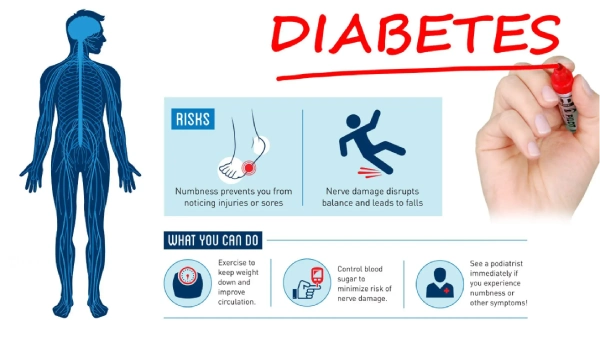
Foot health is a critical concern for diabetics. With complications like poor circulation, nerve damage, and slow wound healing arising from high blood sugar levels, proper foot care is essential. Among the many treatments available, one popular question remains: Should diabetics wear compression socks to bed? While compression socks help with circulation and swelling during the day, their use at night raises a significant debate. This guide explores the science, benefits, and risks of wearing compression socks overnight, providing insights to help distributors and retailers better understand how these products enhance their offerings. Whether you aim to cater to diabetic customers or boost your product lineup, this guide equips you with the knowledge to make informed decisions for your business.
Diabetes and Foot Health: A Critical Relationship
How Diabetes Impacts Foot Health
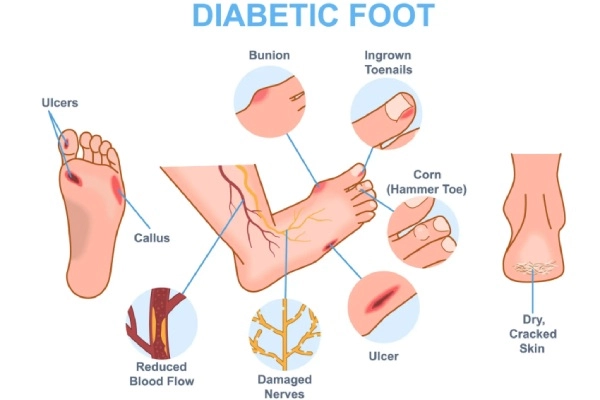
Diabetes can affect the body in ways that may not be immediately noticeable, particularly concerning foot health. Elevated blood sugar levels can damage nerves and blood vessels over time, leading to diabetic neuropathy and circulatory issues. These conditions may cause numbness and loss of sensation in the feet, making it difficult for individuals to notice injuries or discomfort that would otherwise indicate a problem.
The Role of Diabetic Neuropathy
Diabetic neuropathy is a type of nerve damage that can occur with diabetes. It often affects the legs and feet, leading to symptoms such as tingling, pain, or loss of sensation. This loss of feeling can result in unnoticed injuries, as individuals may not feel a pebble inside their sock or a blister on their foot, which can lead to cuts and sores that may become infected.
Circulatory Issues and Delayed Healing
In addition to reduced sensation, diabetes can lower the amount of blood flow in the feet. Not having enough blood flowing to the legs and feet can make it hard for a sore or an infection to heal. Sometimes, a bad infection never heals and might lead to gangrene. Gangrene and foot ulcers that do not get better with treatment can lead to an amputation of the toe, foot, or part of the leg.
The Importance of Daily Foot Care
Given these risks, daily foot care becomes imperative. Regularly inspecting the feet and providing the right protection can prevent dangerous outcomes. When individuals with diabetes prioritize foot health, they can reduce complications and enjoy a higher quality of life.
Characteristics and Functions of Diabetic Socks

Enhanced Protection Features
Diabetic socks are specially designed to address the unique needs of diabetic feet, incorporating key protective elements.
- Cushioning & Thick Materials: The use of cushioning and dense fabrics reduces foot pressure and prevents the formation of pressure points, which are major contributors to foot ulcers in diabetic patients.
- Light-Colored Fabric: Light-colored materials are intentionally used to facilitate early detection of injuries or bleeding. This feature enables timely intervention, minimizing the risk of complications.
- Seamless Construction & Non-Irritating Materials: Seamless designs and hypoallergenic fabrics eliminate friction and skin irritation, providing continuous comfort while reducing the likelihood of abrasions or blisters.
Moisture Management and Hygiene
Effective moisture control is a critical function of diabetic socks, directly impacting foot health.
- Moisture-Wicking Properties: These socks are engineered to draw sweat away from the skin, keeping feet dry and inhibiting the growth of bacteria and fungi. Excessive moisture can create an ideal environment for infections, making this feature essential for diabetic patients.
- Reduced Risk of Fungal Infections: By maintaining a dry environment, moisture-wicking technology significantly lowers the susceptibility to fungal conditions like athlete’s foot, a common concern for those with diabetes.
Circulation and Comfort Enhancement
Diabetic socks also prioritize circulatory health and overall comfort.
Comfort-Driven Design: The combination of non-irritating materials, seamless construction, and strategic cushioning ensures optimal comfort for extended wear, making these socks a practical choice for daily use while supporting foot health.
Gentle, Even Compression: The socks apply mild, uniform pressure to promote healthy blood flow, reducing swelling in the feet and lower legs—common issues caused by poor circulation in diabetic individuals.
How Compression Socks Work and Who They Benefit
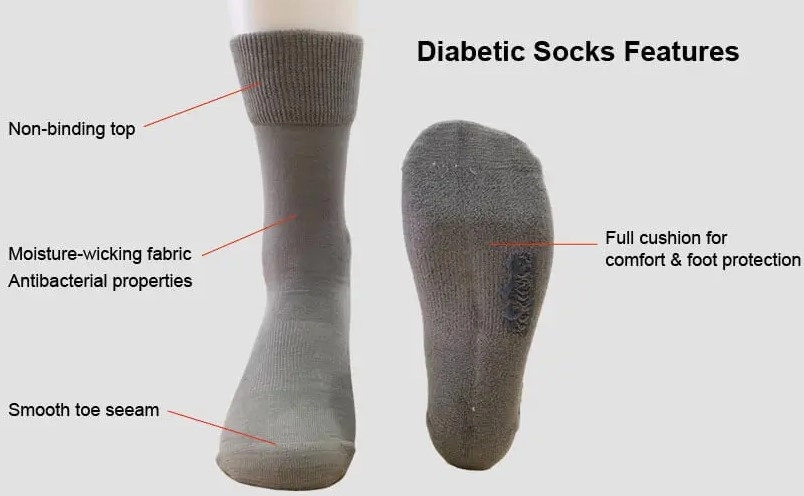
Compression socks are designed to promote better blood flow by applying gentle pressure to the legs and feet. This pressure helps veins, arteries, and muscles in the lower extremities work more efficiently, pushing blood back toward the heart. The increased circulation helps alleviate swelling, pain, and the heavy feeling in the legs that many people experience after prolonged sitting or standing.
Who Benefits from Compression Socks
Individuals with Circulatory Issues
Compression socks are particularly valuable for those with poor circulation, as they significantly reduce the risk of thrombosis—blood clot formation in veins. By maintaining steady blood flow and preventing stasis, these socks act as a proactive tool for cardiovascular health, making them essential for individuals at risk of deep vein thrombosis (DVT) or chronic venous insufficiency.
Diabetic Patients
For diabetic patients experiencing swollen feet or legs, compression socks offer targeted relief. The improved blood flow they promote helps reduce fluid retention and swelling, addressing a common complication of diabetes. By enhancing circulatory efficiency, these socks can alleviate discomfort and support overall foot and leg health in diabetic populations.
Others in Specific Situations
Compression socks benefit a broader range of individuals, including:
Athletes and Long-Distance Travelers: Improved circulation helps reduce fatigue, swelling, and the risk of DVT during prolonged activity or inactivity, allowing for sustained comfort and performance.
Postoperative Patients: They aid recovery by minimizing swelling and promoting blood flow during immobility.
Lymphedema Sufferers: Gentle compression supports lymphatic function and reduces tissue swelling.
Should Diabetics Wear Compression Socks to Bed?
Effectiveness of Compression Socks During Day and Night
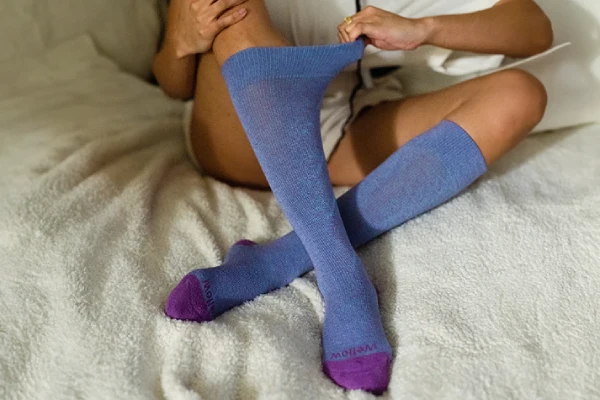
While compression socks are highly effective during the day by supporting blood flow and reducing swelling, their necessity at night is debated. When lying down, gravity no longer hinders circulation, making the pressure exerted by the socks less effective. As a result, wearing compression socks at night may not offer significant circulatory benefits for most individuals.
Situations Where Nighttime Use Might Be Helpful
There are certain cases where wearing compression socks at night could be beneficial. Individuals recovering from surgery or those with severe venous insufficiency may benefit from continued compression while sleeping, as it helps maintain fluid reduction and supports the body’s healing process. Additionally, people with lymphedema or severe swelling may find that wearing compression socks overnight preserves the benefits achieved during the day.
Risks and Recommendations for Diabetics Wearing Compression Socks at Night
Wearing compression socks while sleeping is generally not recommended for most people, including diabetics. The lack of gravitational influence at night means the pressure from socks may cause discomfort, disrupt sleep, and potentially lead to skin irritation or restrict blood flow if the socks are too tight. Improper use could worsen circulation problems.
For diabetic patients, consulting a healthcare provider before wearing compression socks overnight is essential. While doctors may recommend them for specific medical conditions in some cases, this should only be done under professional guidance to avoid risks.
Compression Socks Usage Recommendations
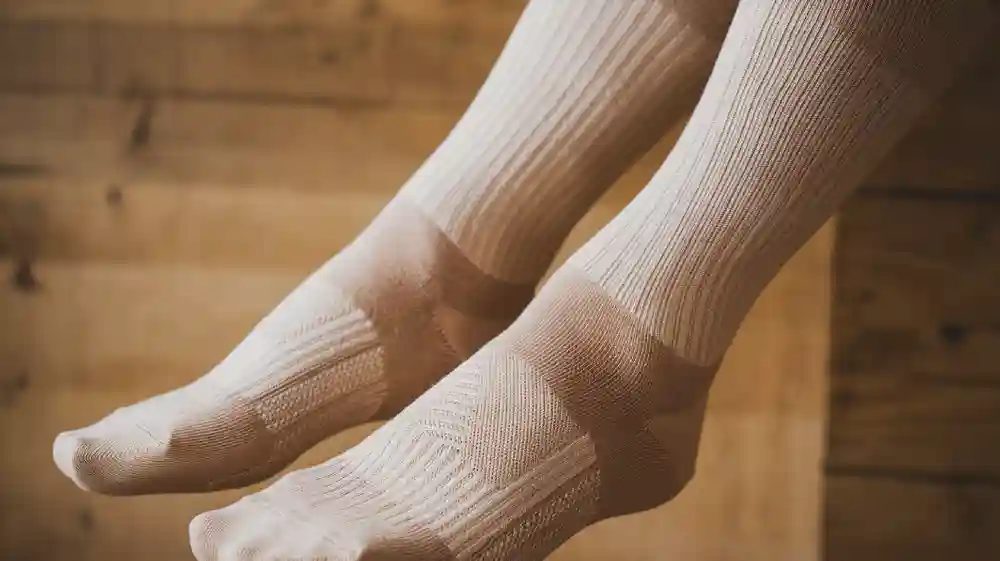
When and How Long to Wear Compression Socks
Compression socks are typically worn for 12-16 hours a day, especially during periods of prolonged standing, sitting, or travel. They are particularly helpful for people who spend long hours on their feet or are frequently in motion, as they help maintain optimal circulation and reduce swelling.
For medical purposes, some individuals, including diabetics, may need to wear compression socks for extended periods as part of their recovery process. For example, individuals recovering from surgery or with venous insufficiency may benefit from prolonged wear to prevent fluid buildup and reduce swelling. It’s vital to follow a healthcare provider’s advice on wear time to ensure safety and effectiveness.
Selecting the Right Compression Socks
When choosing compression socks, selecting the right compression level, size, and type is essential. Compression socks come in various compression levels, ranging from mild to high pressure. For general use, mild or moderate compression levels are sufficient. For more severe conditions, such as venous insufficiency or post-surgical recovery, higher pressure may be required.
Understanding the difference between graduated compression and TED hose is crucial when selecting compression socks. Graduated compression socks provide higher pressure at the ankle and gradually decrease up the leg, ideal for improving circulation. TED hose, on the other hand, offers a uniform pressure level, typically used during postoperative recovery or for immobile patients.
Ultimately, choosing the right compression socks involves understanding the patient’s condition and consulting with a healthcare provider to select the appropriate fit and pressure level.
How to Choose the Right Compression Socks for Diabetic Patients
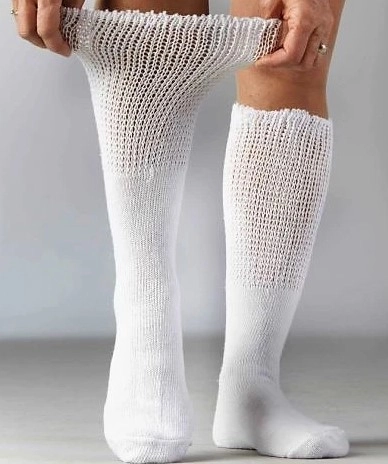
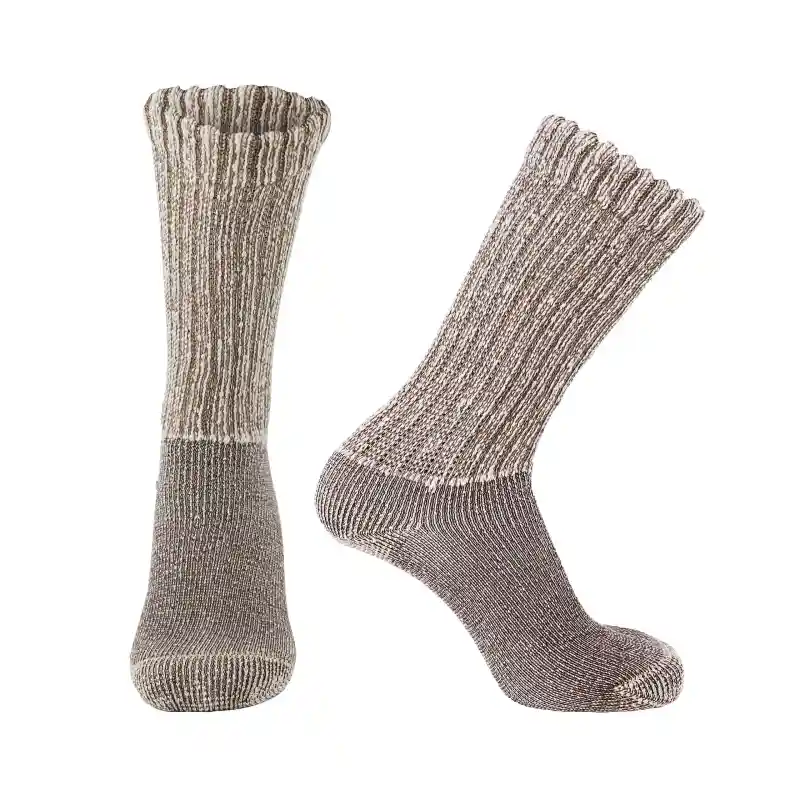
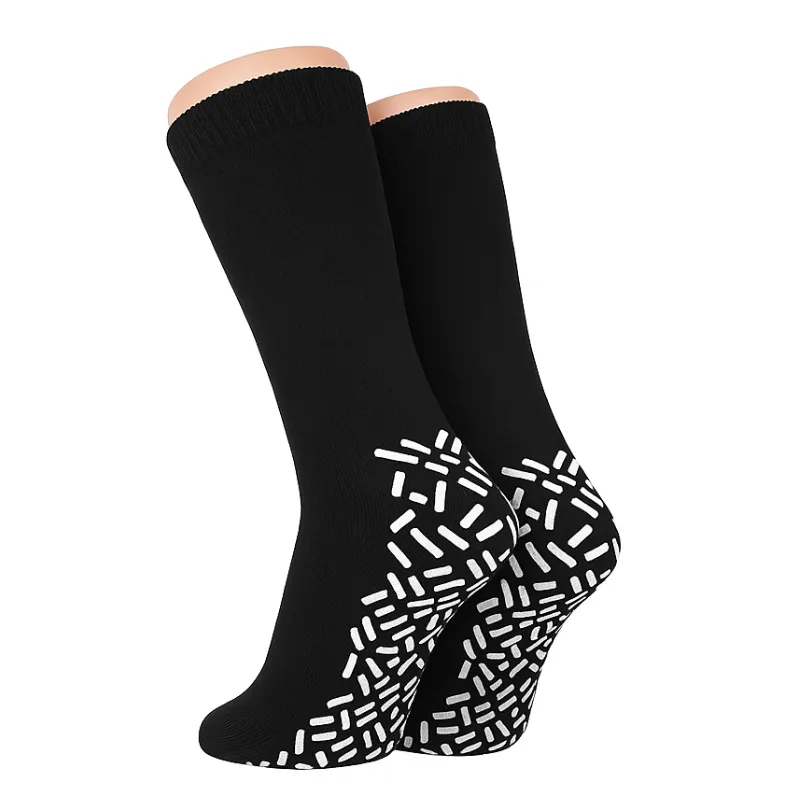
Key Factors: Compression Level and Size
Choosing the right compression socks for diabetic patients requires careful consideration of compression level, size, and type. Each factor plays a role in ensuring proper circulation and preventing complications.
The compression level is one of the most important factors. Compression socks come in various pressure levels, from low to high. For diabetic patients, it’s important to choose a compression level that provides enough support without impairing circulation. Low compression (8-15 mmHg) is ideal for minor swelling, while medium compression (15-20 mmHg) is recommended for more severe circulatory issues. High compression (20-30 mmHg and above) should be used under medical supervision for conditions like lymphedema or venous disorders.
Size is another key factor. Compression socks should fit snugly without causing discomfort. Proper sizing ensures that the socks apply uniform pressure and promote healthy circulation. Diabetic patients should measure their ankles, calves, and legs to ensure proper fit. Incorrect sizing can lead to discomfort or worsen circulation problems.
Seeking Professional Assistance
If self-measuring is difficult, seeking professional assistance is recommended. Healthcare providers or professional fitters can ensure the socks fit correctly and provide the necessary therapeutic effects.
Diabetic socks being pulled on, showing the loose-fitting, stretchy cuff
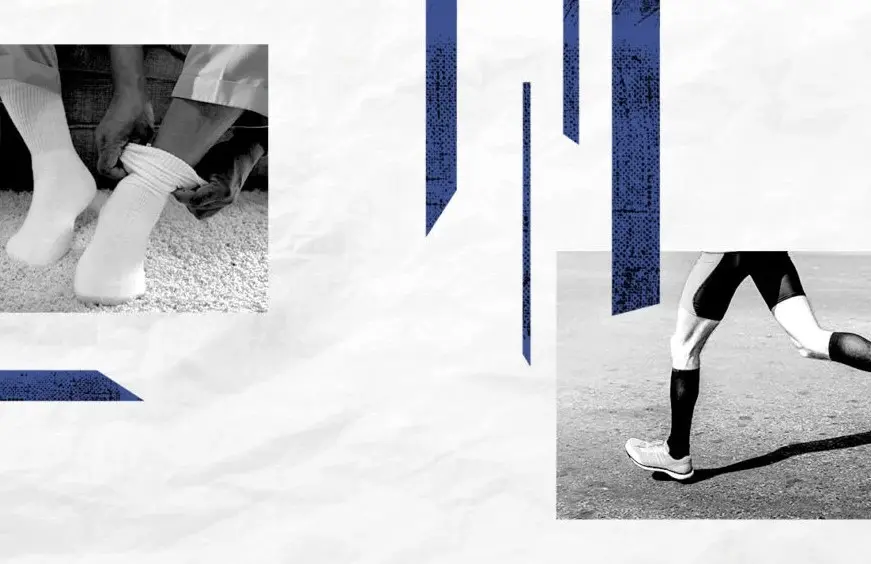
When used correctly, compression socks are a safe and effective tool for managing circulatory issues in diabetic patients. Research has shown that these socks can improve circulation, reduce swelling, and prevent blood clots. However, using them incorrectly, such as over-tightening, can cause discomfort and restrict blood flow.
Over-tightening the socks can lead to skin irritation, pain, and even worsen circulation. It’s crucial to ensure that the socks fit comfortably and provide gentle, consistent pressure. Regularly inspecting the feet for signs of irritation, redness, or discoloration is also important.
If discomfort or pain occurs, it’s essential to remove the socks and consult a healthcare provider. For individuals with severe peripheral arterial disease (PAD), extra caution is necessary. PAD reduces blood flow to the legs, and compression socks can exacerbate circulation issues. In such cases, they should only be worn under medical supervision.
FAQ
Can diabetics wear compression socks overnight?
Compression socks are generally not needed overnight unless prescribed by a doctor. They’re more effective during the day when gravity impacts circulation.
What are the benefits of compression socks for diabetic foot health?
They improve circulation, reduce swelling, and prevent fluid retention, helping to avoid complications like blood clots or ulcers.
How do I choose the right compression socks for diabetics?
Choose based on compression level, size, and breathable, moisture-wicking fabric to ensure comfort and prevent infections.
Are there any risks of using compression socks for diabetics?
Ill-fitting socks can cause discomfort and worsen circulation. Proper sizing is crucial, especially for those with peripheral arterial disease (PAD).
How can I offer custom compression socks for diabetics?
Offer custom socks with adjustable compression, seamless designs, and moisture-wicking materials to meet diabetic needs and differentiate your brand.
Conclusion: Should Diabetics Wear Compression Socks to Bed? Final Thoughts

In conclusion, wearing compression socks overnight is generally not necessary for most diabetics. They are most beneficial during the day when circulation problems are most prominent. However, in certain cases, such as severe venous insufficiency or postoperative recovery, wearing them overnight may be recommended under medical guidance.
If you’re interested in offering your customers high-quality custom compression socks, contact us today. We’re ready to help you enhance your product offerings with tailored solutions designed to meet the specific needs of diabetic patients.
